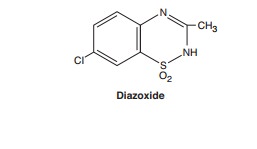Chapter: Basic & Clinical Pharmacology : Antihypertensive Agents
Diazoxide
DIAZOXIDE
Diazoxide
is an effective and relatively long-acting parenterally administered arteriolar
dilator that is occasionally used to treat hypertensive emergencies.
Diminishing usage suggests that it may be withdrawn. Injection of diazoxide
results in a rapid fall in sys-temic vascular resistance and mean arterial
blood pressure. Studies of its mechanism suggest that it prevents vascular
smooth muscle contraction by opening potassium channels and stabilizing the
membrane potential at the resting level.

Pharmacokinetics & Dosage
Diazoxide
is similar chemically to the thiazide diuretics but has no diuretic activity.
It is bound extensively to serum albumin and to vascular tissue. Diazoxide is
partially metabolized; its metabolic pathways are not well characterized. The
remainder is excreted unchanged. Its half-life is approximately 24 hours, but
the relation-ship between blood concentration and hypotensive action is not
well established. The blood pressure-lowering effect after a rapid injection is
established within 5 minutes and lasts for 4–12 hours.
When
diazoxide was first marketed, a dose of 300 mg by rapid injection was
recommended. It appears, however, that excessive hypotension can be avoided by
beginning with smaller doses (50–150 mg). If necessary, doses of 150 mg may be
repeated every 5 to 15 minutes until blood pressure is lowered satisfactorily.
Nearly all patients respond to a maximum of three or four doses. Alternatively,
diazoxide may be administered by intravenous infu-sion at rates of 15–30
mg/min. Because of reduced protein bind-ing, hypotension occurs after smaller
doses in persons with chronic renal failure, and smaller doses should be
administered to these patients. The hypotensive effects of diazoxide are also
greater when patients are pretreated with β blockers to prevent the reflex tachycardia
and associated increase in cardiac output.
Toxicity
The
most significant toxicity from diazoxide has been excessive hypotension,
resulting from the recommendation to use a fixed dose of 300 mg in all
patients. Such hypotension has resulted in stroke and myocardial infarction.
The reflex sympathetic response can provoke angina, electrocardiographic
evidence of ischemia, and cardiac failure in patients with ischemic heart
disease, and diazoxide should be avoided in this situation.
Diazoxide
inhibits insulin release from the pancreas (probably by opening potassium
channels in the beta cell membrane) and is used to treat hypoglycemia secondary
to insulinoma. Occasionally, hyperglycemia complicates diazoxide use,
particularly in persons with renal insufficiency.
In
contrast to the structurally related thiazide diuretics, diazox-ide causes renal
salt and water retention. However,
because the drug is used for short periods only, this is rarely a problem.
Related Topics